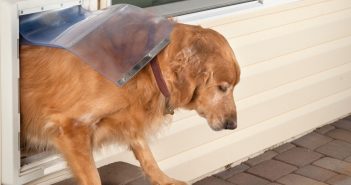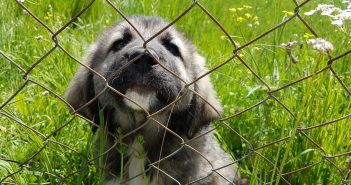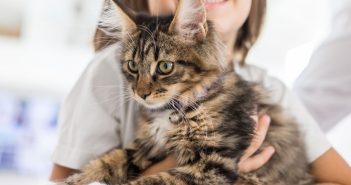In our world sight and hearing are far more important to us than our sense of smell.
Granted the smell of fresh baked bread or a steak cooking on the grill can make us weak in the knees, but on the whole, smell is really not the most important thing in our lives.
In the lives of our cats and dogs smell is extremely important. A blind or deaf cat or dog can lead a fairly normal life as long as its nose is in working order.
From the very moment a puppy or kitten is born, smell becomes the most important part of their lives. A newborn can find mommy and its favorite nursing nipple just by smelling.
Dogs have a “superman” sense of smell, they have 280 million receptors that help them smell. Cats come n in a close second with 100 million receptors and the lowly human has only 20 million.
Cats and dogs use their sense of smell to “see” their world.
The ability to determine from a scent left by a visiting animal of when it was there, its state of health, sex and what kind of animal it was, is rather amazing.
To us a pile of feces on the lawn is a mess to clean up; to your dog, it is filled with information about the dog that left it.
Sidewalks, trees, fire hydrants and plants provide all kinds of information for our cats and dogs about friends or foe that have been there.
As hard as it is for us to realize that all those “nasty” moments of smelling, dogs do to each other, is a very important part of their communication.
We shake hand to size up a person, dogs use smell to do the same thing. Their behavior is perfectly acceptable in a dog’s world and we, as humans need to come to terms with it and not be embarrassed.
Actually, we should encourage it, as it helps to socialize your dog and it makes him/her happier.
Smell is so important in our pet’s life that nature gave them 2 organs to detect smell with. The first one of course, is the nose. Their noses are constructed in a similar fashion to ours. Once the air enters the nose it is warmed and moistened and then some air is funneled into thin folds called the olfactory mucosa. This is where those millions of receptors are.
In order for you to understand the difference between our pets and we humans, when it comes to our smelling ability, let’s discuss receptor sizes. Our 20 million receptors take up about ½ square inch, our cat’s 100 million take up to 6 square inches and our friend the dog, depending on breed size can take up to 20 square inches.
That certainly explains the long noses some dogs have.
If you ever wondered why a dog’s nose is moist, it is because it makes smelling easier.
In addition to a nose, cats and dogs have another organ that helps them smell. It is called the Jacobson’s organ. This is an interesting organ, it is a tube located in the nasal septum that is paired with some nerve endings on the roof of the mouth.
The Jacobson’s organ has just one job to detect odors that are linked with food or sex. When those smells are detected, signals are sent to the part of the brain that controls appetite or the sex drive.
Cats have a unique behavior associated with the Jacobson’s organ: it is call flehmen. This behavior happens when a cat smells something really interesting, like a female in heat. It causes the cat to arch its neck, lift its head, curl back its top lip and open its mouth. The look apparently gives the cat an angry look or a look of someone quite out of it.
Having had cats for many years, I have yet to see this behavior, possibly because my cats have all been neutered or spayed.
This seems to be a tom cat trait more than any other.
Smell to our pets is almost like reading the newspaper. Smell is an information source, they can tell who has passed through, what they have eaten or rolled in.
If they could talk, they could even tell you what someone is cooking 4 blocks away from the house. Believe it or not, if your neighbor was cooking fish, your dog (if it could talk) would be able tell you what kind of fish it was, where it came from, what chemicals were in the water and how long it had lived there.
Your dog could tell that just from the smell. Wild isn’t it?
A dog’s sense of smell is at least 100,000 times better then our sense of smell. Not only that, dogs have the ability to remember smells, once the smell has registered in the “smell chamber” a dog will never forget it.
Wouldn’t it be great if they could remember all the commands we teach them the same way?
That is why it is hard to lie to a dog, our body language and our smell when we are trying to convince our dog that going to the vet is fun, gives us away.
Why did I bother to write on “pet smelling?” One of the reasons is that we, as busy humans, often do not take the time to smell the roses growing in our own yards. We really don’t even think about smelling, until we smell something that smells good or bad.
We take our dogs out for a walk and get annoyed when they stop every three feet to smell the grass or a tree.
It never dawns on us that they are gathering information for themselves, just as we do from the newspaper, radio or TV.
You might consider smelling a social exercise for pets. Let your dog smell other friendly dogs and do not be embarrassed by it. If they could talk and shake hands they would, but nature gave them noses to do the same thing.
So the next time you are out walking your dog remember these few pages and let your dog smell things.
There are many times that I would like to get inside the head of one of my cats, in order to figure out why it is doing, what it is doing. Since I can’t, I find it interesting to learn what makes their world go round and smell is an important part of their world. If you have enjoyed this article please come and visit me at www.cats-and-dogs-on-the-web.com/



